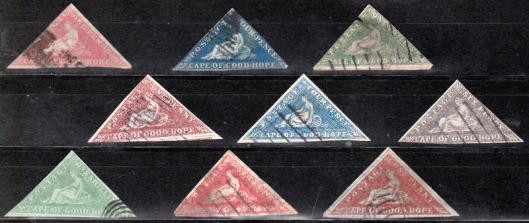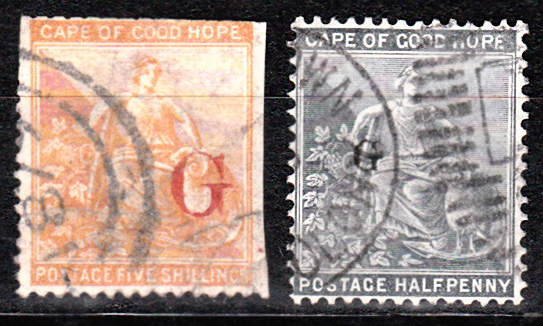The Cape of Good Hope
Quote from Harald Zierock on August 6, 2020, 8:55 pm
The Cape of Good Hope is located at the southern tip of Africa. The capital is Cape Town. The "Dutch" of the Dutch East Indian Company were the first in this region. In 1795 the British used Cape Town as a naval base. They took over more and more territory and abolished slavery in the north of the Orange River Colony. A war ensued which the Boers lost and in 1910 the Union of South Africa was founded. In 1871 the Cape Colony became part of the "Griqualand" and in 1877 part of the Transvaal. Bechualand was absorbed in 1890. The Cape of Good Hope began issuing stamps in 1853 in the form of triangular stamps. These were the first triangular stamps in the world. They were issued in this way to distinguish them immediately from other stamps.
The stamps shown above have not yet been checked to certify their authenticity.
Griqualand were Cape Town stamps overprinted with a G. Here is a picture of them so that everyone can see what they are even if the first one is faulty.
The Cape of Good Hope is located at the southern tip of Africa. The capital is Cape Town. The "Dutch" of the Dutch East Indian Company were the first in this region. In 1795 the British used Cape Town as a naval base. They took over more and more territory and abolished slavery in the north of the Orange River Colony. A war ensued which the Boers lost and in 1910 the Union of South Africa was founded. In 1871 the Cape Colony became part of the "Griqualand" and in 1877 part of the Transvaal. Bechualand was absorbed in 1890. The Cape of Good Hope began issuing stamps in 1853 in the form of triangular stamps. These were the first triangular stamps in the world. They were issued in this way to distinguish them immediately from other stamps.
The stamps shown above have not yet been checked to certify their authenticity.
Griqualand were Cape Town stamps overprinted with a G. Here is a picture of them so that everyone can see what they are even if the first one is faulty.
Uploaded files:Quote from Steve on August 7, 2020, 8:59 amThis is good stuff, excatly how we hoped the Forum would be used.
As I have quite a collection of Cape forgeries and also Griqualand, which I hope to post in the coming months, this is of interest to me.
Griqualand became part of the Cape Colony, not the other way round. At first the Cape Colony refused to incorporate it so the British made Griqualand a separate colony which was finally absorbed by the Cape Colony in 1877. The ZAR (Transvaal) acquired little or no Griqua land, unlike the OFS (Orange Free State). My Griqualand postal history display shows how the Boers acquired Griqua land, specifically farms which they bought, then lodged their purchase in Bloemfontein, the OFS capital, which then declared the land a part of the OFS. That is a simplistic explanation for how Griqua farmland changed hands but it is fundamentally correct.
I can see that most of the triangles are forgeries designed for the low-end 'space-filler' market. The ones that attempt a very poor 'Grahamstown' hand roller canceller are most likely by Philip Spiro who used this fake postmark widely. The concentric circle postmark is another very common fake canceller, as is the last, bottom right, which is also by Spiro.
The first two triangles, top left, I cannot see clearly enough to make a determination on but one or both could be genuine.
I attached a sheet of my own - "How to Detect Forged Cape Triangles".
This is good stuff, excatly how we hoped the Forum would be used.
As I have quite a collection of Cape forgeries and also Griqualand, which I hope to post in the coming months, this is of interest to me.
Griqualand became part of the Cape Colony, not the other way round. At first the Cape Colony refused to incorporate it so the British made Griqualand a separate colony which was finally absorbed by the Cape Colony in 1877. The ZAR (Transvaal) acquired little or no Griqua land, unlike the OFS (Orange Free State). My Griqualand postal history display shows how the Boers acquired Griqua land, specifically farms which they bought, then lodged their purchase in Bloemfontein, the OFS capital, which then declared the land a part of the OFS. That is a simplistic explanation for how Griqua farmland changed hands but it is fundamentally correct.
I can see that most of the triangles are forgeries designed for the low-end 'space-filler' market. The ones that attempt a very poor 'Grahamstown' hand roller canceller are most likely by Philip Spiro who used this fake postmark widely. The concentric circle postmark is another very common fake canceller, as is the last, bottom right, which is also by Spiro.
The first two triangles, top left, I cannot see clearly enough to make a determination on but one or both could be genuine.
I attached a sheet of my own - "How to Detect Forged Cape Triangles".
Uploaded files:



